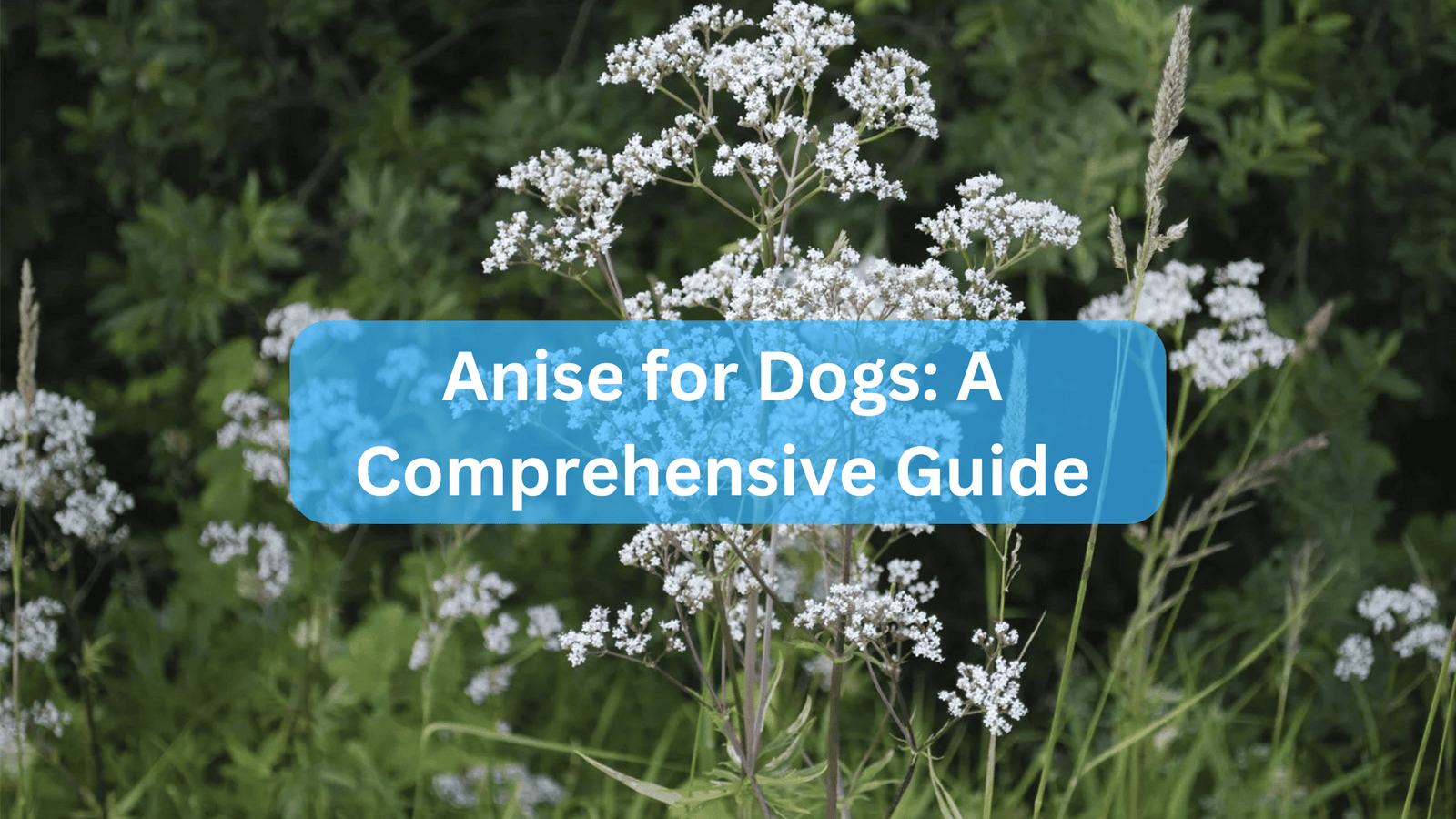In this comprehensive guide, we will explore the uses, benefits, risks, and proper administration of anise for dogs. This article aims to provide dog owners with a thorough understanding of this unique spice and how it can be safely incorporated into their pets’ lives.
What is Anise?
Anise, a spice commonly used in cooking and baking, is derived from the seeds of the Pimpinella anisum plant belonging to the Apiaceae family.
It is native to the eastern Mediterranean region and Southwest Asia.
The plant produces small, brown seeds that are harvested and used as a spice.
These seeds are known for their distinctive flavor, which resembles that of licorice, fennel, and star anise.
Anise is rich in essential oils, with anethole being the primary component responsible for its characteristic taste and aroma.
Nutritional Composition of Anise
Anise seeds are packed with nutrients and bioactive compounds, making them a valuable addition to a dog’s diet when used appropriately. Key components include:
- Anethole: The main active compound, known for its flavor and potential health benefits.
- Fiber: Aids in digestion and promotes a healthy gastrointestinal tract.
- Vitamins: Includes B vitamins, vitamin C, and vitamin A, which support various bodily functions.
- Minerals: Contains calcium, iron, magnesium, potassium, and zinc, essential for overall health.
How Does Anise for Dogs Work?

The Science Behind Anise’s Effects on Dogs
Anise’s impact on dogs primarily stems from its active compound, anethole. This compound is responsible for the spice’s distinctive flavor and aroma, and it interacts with the dog’s olfactory system and gastrointestinal tract in various beneficial ways.
1. Olfactory Stimulation
Dogs have an incredibly keen sense of smell, far superior to that of humans.
When dogs are exposed to the scent of anise, the anethole molecules stimulate their olfactory receptors.
This stimulation can trigger a range of behaviors, from heightened excitement and playfulness to focused attention.
Some dogs may react to anise similarly to how cats react to catnip, showing increased activity and engagement.
2. Behavioral Benefits
The excitement and stimulation provided by anise can be particularly useful for behavioral enrichment.
Dogs that are bored, anxious, or prone to destructive behavior can benefit from the stimulating effects of anise.
It can encourage play and exercise, helping to alleviate boredom and reduce stress.
For working dogs, such as search and rescue dogs, anise can be used as a motivational tool during training sessions.
3. Digestive Health
Anise has carminative properties, meaning it helps to reduce gas and bloating in the digestive system.
The anethole in anise stimulates the digestive tract, promoting the secretion of digestive enzymes and bile.
This can aid in the digestion of food, improve appetite, and alleviate discomfort associated with indigestion.
Additionally, the fiber content in anise seeds supports overall gastrointestinal health by promoting regular bowel movements.
4. Antimicrobial and Anti-inflammatory Properties
Anise contains natural antimicrobial agents that can help maintain oral hygiene and prevent infections.
The essential oils in anise, particularly anethole, have been shown to exhibit antibacterial and antifungal properties.
This can be beneficial for preventing oral health issues and supporting the immune system.
Furthermore, anise’s anti-inflammatory properties can provide relief for dogs with conditions such as arthritis or inflammatory bowel disease.
The compounds in anise reduce inflammation and soothe irritated tissues, contributing to overall well-being.
5. Calming Effects
While anise is generally known for its stimulating effects, it can also have a calming influence on some dogs.
The spice can help reduce anxiety and promote relaxation in stressful situations, such as during thunderstorms or fireworks displays.
The dual action of stimulation and calmness makes anise a versatile tool for managing various behavioral and health-related issues.
How to Use Anise for Dogs
Anise Seeds
Anise seeds can be ground into a powder and sprinkled onto your dog’s food. It’s important to use them in moderation, as excessive amounts can cause adverse effects.
A pinch of ground anise seed mixed into the food once or twice a week is usually sufficient.
Anise Extract
Anise extract, a concentrated form of the spice, can be used to make dog treats or added to water.
Ensure the extract is free from alcohol, as alcohol can be harmful to dogs. A few drops of anise extract can be added to homemade dog treats or water bowls.
Anise Essential Oil
While anise essential oil is potent and should be used with caution, it can be used in very small amounts.
Always dilute the oil with a carrier oil before use and avoid direct ingestion. Anise essential oil can be used in homemade shampoos or diluted and applied to bedding to stimulate interest.
Safety and Precautions
While anise can offer several benefits to dogs, it’s crucial to use it responsibly. Here are some safety tips:
- Moderation is Key: Overuse of anise can lead to adverse effects such as vomiting, diarrhea, and nervous system issues.
- Consult a Veterinarian: Before introducing anise to your dog’s diet, consult your veterinarian, especially if your dog has existing health conditions or is on medication.
- Watch for Allergic Reactions: Monitor your dog for any signs of allergic reactions, such as itching, swelling, or gastrointestinal upset. If any adverse reactions occur, discontinue use immediately and seek veterinary advice.
Practical Applications and Recipes Of Anise for Dogs

Anise-Infused Dog Treats
Making homemade dog treats with anise is a great way to incorporate the spice into your dog’s diet. Here’s a simple recipe to get you started:
Anise Dog Biscuits
Ingredients:
- 2 cups whole wheat flour
- 1/2 cup rolled oats
- 1/4 cup ground anise seeds
- 1/2 cup unsweetened applesauce
- 1/4 cup peanut butter (ensure it does not contain xylitol)
- 1/2 cup water
Instructions:
- Preheat your oven to 350°F (175°C).
- In a large bowl, combine the whole wheat flour, rolled oats, and ground anise seeds.
- Add the applesauce, peanut butter, and water. Mix until a dough forms.
- Roll out the dough on a floured surface to about 1/4 inch thickness.
- Use cookie cutters to cut out shapes and place them on a baking sheet lined with parchment paper.
- Bake for 20-25 minutes or until golden brown.
- Allow the biscuits to cool completely before serving them to your dog.
Anise-Infused Water
If your dog enjoys the flavor of anise, you can make anise-infused water as a refreshing treat.
Anise-Infused Water Recipe
Ingredients:
- 1 quart of water
- 1 teaspoon anise seeds
Instructions:
- Boil the water and add the anise seeds.
- Let it steep for about 20 minutes.
- Strain the water to remove the seeds.
- Allow the infused water to cool completely.
- Serve a small amount to your dog, ensuring it does not exceed their regular water intake.
Anise in Dog Toys
Anise can also be used to make toys more appealing to dogs. You can create an anise-scented toy by sprinkling a small amount of ground anise or anise extract onto a cloth toy or a piece of fabric. Ensure the toy is safe and non-toxic.
DIY Anise-Scented Toy
Materials:
- A durable cloth toy or a piece of fabric
- 1 teaspoon ground anise or a few drops of anise extract
Instructions:
- Sprinkle the ground anise or anise extract onto the toy.
- Rub the spice or extract into the fabric to distribute the scent evenly.
- Allow the toy to dry completely if you used an extract.
- Give the toy to your dog and supervise their playtime.
Also Read: NexGard Plus for Dogs: Complete Dog Parasite Protection
Also Read: Why is my dog shaking and not eating? You’re Not Alone
Conclusion
Anise can be a beneficial and enjoyable addition to your dog’s life when used appropriately.
Its potential benefits for behavior, digestion, and overall health make it a versatile spice for canine use.
However, it’s essential to use anise in moderation and consult with your veterinarian before introducing it to your dog’s diet or routine.
By understanding the proper uses and precautions, you can safely incorporate anise into your dog’s care regimen, enhancing their well-being and adding a new dimension to their daily experiences.
Sources:







